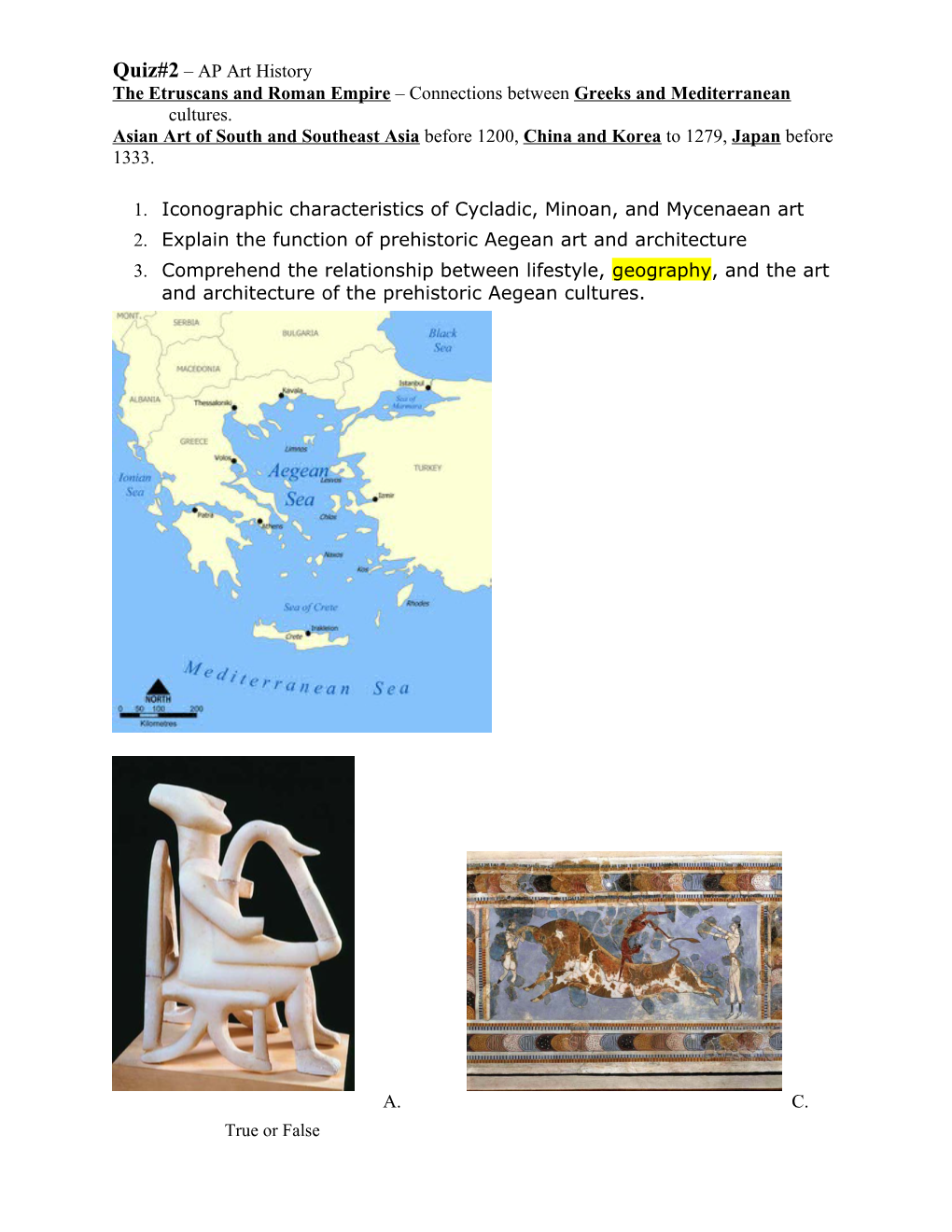Quiz#2 – AP Art History
The Etruscans and Roman Empire – Connections between Greeks and Mediterranean cultures.
Asian Art of South and Southeast Asia before 1200, China and Korea to 1279, Japan before 1333.
1. Iconographic characteristics of Cycladic, Minoan, and Mycenaean art
2. Explain the function of prehistoric Aegean art and architecture
3. Comprehend the relationship between lifestyle, geography, and the art and architecture of the prehistoric Aegean cultures.
A. C.
True or False
A. 20. This figure reflects the same simple geometric shapes and large flat planes
seen in other Cycladic work.
21. Marble.
C. 23. The fluid, curving line suggests the spontaneous nature of the people, and
that echoes in this work as the scene is vigorous and energetic.
24. The Minoan ceremony of bull-leaping: the figures are presented in the
conventional manner, the women are pale and the male is dark; however, the artist has implied the power of the bull by the sweeping line of his upper body and further augments that by the full stretch of the animal.
25. The angularity of Egyptian murals has been modified by the curving line
of the Minoans, an essential component of their design vocabulary. The
verticality of the figures has been softened by the curves.
26. True fresco (applying paint to the wet surface).
4. Explain the formal and iconographic characteristics of Geometric, Orientalizing, Archaic, Classical, and Hellenistic period art.
5. Explain the artistic and architectural theories governing ancient Greek art and architecture.
6. Discuss the materials, techniques, and processes used to create Greek art and architecture.
7. Identify historical events and characters that exerted influence on the development of Greek art and architecture.
Geometric Orientalizing Archaic Early & High Classical Late Classical
Hellenistic
The Altar of Zeus, Pergamon, presents in mythological disguise the victory of Attalos I over the ______. a. Romans c. Persians
b. Athenians d. Gauls
A. Parthenon, Acropolis, Athens (Figure 5-44)
21. How does this work conform to the period?
22. How is this work original?
23. Who is/are the architect and/or architects?
24. What is the period?
B. Aphrodite of Knidos (Figure 5-62)
25. How does this work reflect the period?
26. Who is the sculptor?
C. Athena battling Alkyoneos, detail of the gigantomachy frieze, from the Altar of Zeus (Figure 5-79)
27. Who is depicted in this work?
28. Why is this work significant?
29. How does this image express power?
30. What is the medium?
38. What is the radical change in the Kritios Boy from earlier Greek statues?
39. Define contrapposto.
41. From a Greek architectural point of view, what makes the Parthenon “perfect?”
43. Describe the change in Greek thought and art in the fourth century BCE.
8. Explain how Buddhist beliefs were reflected in the art and architecture of ancient India and Southeast Asia
9. Explain how Hindu beliefs were reflected in art and architecture in ancient India and Southeast Asia
10. Identify the materials and formal strategies ancient Indian and Southeast Asian artists employed to represent Hindu and Buddhist themes
11. Describe the significant artistic and architectural elements of the dynasties prior to the Period of Disunity (Shang, Zhou, Qin, and Han)
12. Discuss the impact the Buddhism had on Chinese art and architecture
13. List the materials and formats used by Chinese painters
14. Discuss the artistic and architectural accomplishments of each of the pre-Buddhist periods in Japan
15. Distinguish between pre-Buddhist (Shinto) and Buddhist shrine architectural strategies
16. Describe the materials and styles of Japanese Buddhist sculpture
9. Where did the Buddha give his First Sermon?
a. Sarnath c. Karle
b. Sanchi d. Ajanta
10. Gandharan sculpture is modeled after ______art in its treatement of the body and drapery.
a. Egyptian c. Hindu Nicator
b. Minoan d. Greco-Roman
Which of the following refers to an amorous couple; a very popular sculptural motif that can be found on temple architecture?
a. Ushnishas c. Mithunas
b. Urnas d. Avatars
The caves of Ajanta are famed for which of the following?
a. later Indian painting tradition b. history of the reign of Ashoka
c. sexually explicit sculpture d. early Indian painting tradition
44. Discuss the similarities between Hinduism and Buddhism.
Describe the formal and iconographic characteristics of Etruscan art.
17. Explain the forms, materials, and construction of Etruscan architecture.
18. Describe the relationship between Etruscan and Roman art and history.
19. Identify the formal and iconographic characteristics of Roman art and architecture of the Republican and Early, High, and Late Imperial periods.
20. Describe the forms, materials and construction techniques of Roman architecture
21. Discuss relationship of civic building programs and imperial politics
